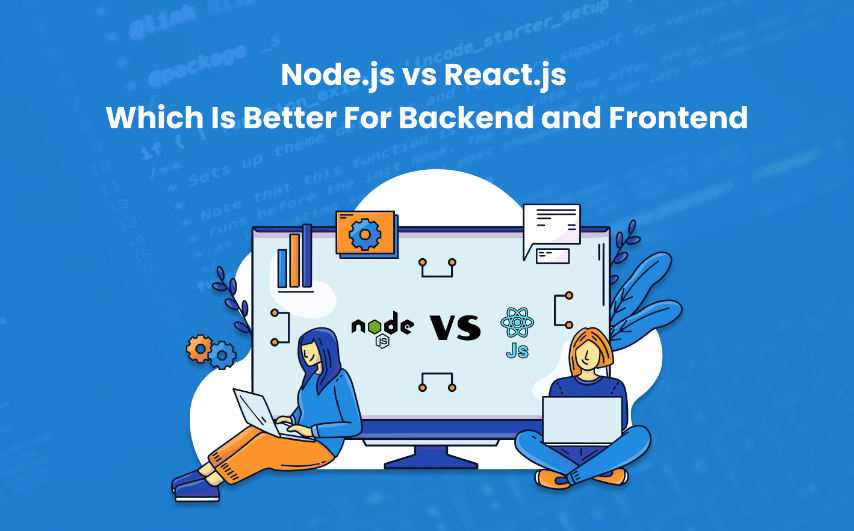Node.js and React.js are distinct JavaScript technologies with different purposes. Node.js serves as a backend framework, enabling backend development in JavaScript, while React.js is a frontend library used for crafting user interfaces.
Despite their differences, both technologies enhance application performance and ease of management. It’s crucial for developers to comprehend these technologies thoroughly to make informed choices for their projects.
Node.js excels on the server-side, while React.js shines in the frontend. Each has its own set of advantages and disadvantages, along with specific use cases.
Understanding these characteristics empowers developers to select the most suitable technology for their JavaScript projects, ensuring optimal outcomes.
What is Node.js?
Node.js, created by Ryan Dahl, harnesses the power of the Google Chrome V8 engine. It stands as a lightweight and efficient JavaScript framework primarily designed for backend development. Node.js excels in tasks like database management, API hosting, and handling HTTP requests with remarkable efficiency.
Key Characteristics of Node.js include:
- Asynchronous and Event-Driven:
Node.js adopts an asynchronous and event-driven programming model, ensuring seamless task execution.
- JavaScript Utilization:
Developers can work with JavaScript, and Node.js employs a single-threaded, non-blocking I/O architecture.
- npm Package Management:
Node.js includes npm, a built-in package management system, facilitating easy access to open-source libraries and modules.
- Cross-Platform Compatibility:
Node.js is compatible with Windows, macOS, and Linux, making it versatile for various development environments.
Who uses Node.js?
Node.js is favored by various companies, including industry leaders like Netflix, Trello, and Uber, for several reasons:
- Netflix:
Netflix is a specialist in online video streaming and uses Node.js because of its efficiency and portability. It has helped reduce startup time by 70% and facilitates A/B testing for 93 million users.
- Uber:
For a platform as extensive and dynamic as Uber, Node.js plays a pivotal role as a tech solution. It empowers Uber to scale its services efficiently in response to increasing demand, ensuring seamless experiences for both riders and drivers.
- Trello:
It is a project management app that uses Node.js to control its server-side processes. Node.js is an invaluable asset to Trello developers, particularly in handling system updates that involve a multitude of concurrent connections. This capability ensures the platform’s reliability and responsiveness in supporting collaborative project management.
Advantages of Backend Library Node.JS:
- Coaching of individual modules for improved performance.
- High extensibility, allowing easy integration of additional functionalities.
- Scalability in both horizontal and vertical directions, enhancing flexibility.
- Use Google Chrome V8 to translate JavaScript code into machine code.
- Efficiently handles multiple concurrent connections, making it suitable for API services.
- Ideal for writing fast and lightweight microservices like API gateways.
- Promotes code reusability and supports web development.
Limitations of Backend Library Node.JS:
- Embrace asynchronous programming, which can be challenging for developers used to linear I/O blocking.
- Lacks a rich library compared to some other languages or platforms.
- Asynchronous programming can be complex for those accustomed to linear blocking I/O.
- The absence of a comprehensive library could require developers to rely on third-party packages.
Key Features of Node.js:
- Open-source framework.
- Non-blocking procedures result in improved performance.
- DNS, TCP, and HTTP servers all provide built-in APIs for server building.
- Unit testing capabilities with Jasmine.
- Scalability, allowing vertical and horizontal scaling for improved performance.
What is React?
React.js is an open-source front-end library tailored for structured user interface development in websites and web applications. It places a strong emphasis on delivering dynamic and high-performance development experiences.
Key Characteristics of React.js include:
- Component Reusability:
React.js encourages the reuse of system components, simplifying maintenance and addressing issues related to React updates.
- Virtual DOM Optimization:
Leveraging the Virtual DOM enhances application performance, leading to improved efficiency and faster rendering.
- Comprehensive Developer Tools:
React provides developers with a robust set of debugging and design tools, streamlining high-performance development and troubleshooting.
- Cross-Platform Compatibility:
React empowers the use of consistent design patterns to create rich user interfaces for native apps on both iOS and Android platforms.
Advantages of Frontend Library React.JS
- Encourages code component reusability and promotes efficient development.
- Utilize virtual DOM for enhanced application performance.
- Facilitates faster debugging and improves development efficiency.
- Compatible with iOS and Android mobile operating systems.
- Simplifies UI testing with a user-friendly approach.
- Provides support for both server-side and front-end development.
Limitations of Frontend Library React.JS
- Keeping pace with the constant release of new tools and technologies can be challenging.
- Learning JSX and JavaScript for React development can initially be complex for some developers.
- The rapid evolution of tools and technologies in the React ecosystem may require continuous learning and adaptation.
Who Uses React.js?
React.js, developed by the Facebook team, is adopted by a wide range of applications and platforms, including:
- Facebook:
It is extensively used by Facebook for creating dynamic web app elements, enhancing user interaction and engagement.
- Instagram:
It uses React for features like Google Maps APIs and geolocation, contributing to a smooth and interactive user experience.
- Netflix:
It employs React.js for its Gibbon platform, optimized for low-performance TV devices. React.js enhances runtime performance, speed, and modularity for streaming services.
- Various Applications:
React.js is versatile and applicable in diverse contexts, such as adding dynamic features like multi-currency calculators to two-sided marketplaces.
Key Features of React.js:
- Simplifies maintenance with component reuse.
- Boosts performance through Virtual DOM.
- Ensures code stability and enhanced performance.
- Provides robust developer tools.
- Supports mobile app development for iOS and Android.
Node.js vs React.js Comparison of Javascript Technologies
Here’s a comparison of Node.js and React.js in a table format:
| Node.js | React.js | |
| Type | Backend Framework | Frontend Library |
| Primary Use | Server-side development, APIs, I/O | User Interface (UI) development |
| JavaScript Environment | Backend | Frontend |
| Execution Model | Single-threaded, non-blocking I/O | Single-threaded, non-blocking I/O |
| Event-driven | Yes | Yes |
| Package Manager | npm (Node Package Manager) | npm (Node Package Manager) |
| Cross-platform Compatibility | Windows, macOS, Linux | Web browsers, mobile platforms |
| Component-based | No | Yes |
| DOM Handling | Server-side | Client-side |
| Server-side Rendering (SSR) | Supported (with frameworks like Express) | Supported (with Next.js, Gatsby) |
| Performance | Highly efficient for server tasks | Efficient UI rendering |
| Code Reusability | Not designed for UI components reuse | Promotes UI component reuse |
| Popular Frameworks | Express, Koa, Hapi | Next.js, Gatsby, Create React App |
| Typical Project Types | Web servers, APIs, real-time applications | Web and mobile application user interfaces |
| Key Companies Using | Netflix, Uber, PayPal | Facebook, Instagram, Airbnb |
Use Cases of React.js:
- UI Development: Ideal for creating dynamic and interactive user interfaces.
- Single-Page Apps: Great for building apps that load content without page refresh.
- Cross-Platform Mobile Apps: React Native for Android and iOS app development.
- Real-Time Dashboards: Efficiently handles real-time data updates.
- E-commerce Websites: Enhances shopping experiences with responsive UIs.
- CMS Integration: Modernizes content management systems.
Use Cases of Node.js:
- Web Servers: Powers web servers for handling HTTP requests and APIs.
- Real-Time Apps: Perfect for chat, gaming, and collaborative tools.
- Microservices: Lightweight choice for building scalable microservices.
- Streaming Services: Efficiently manages media streaming platforms.
- IoT Applications: Processes data from connected devices in IoT.
- API Gateways: Routes and aggregates requests in distributed systems.
- Serverless Functions: Used for building AWS Lambda functions in serverless environments.
Node.js vs. React.js: Which One to Choose?
Both Node.js and React.js are modern technologies embraced by successful businesses. However, making the right choice for your project is crucial. Here’s a hint:
If you’re aiming to build a complex and scalable server-side web application, think of Node.js. It’s a great fit for projects like online streaming platforms.
However, if your project involves dynamic user interfaces with changing elements like inputs and buttons, React.js is your ideal companion.
Keep in mind that you can also combine both technologies in your web application. You can use React for the front-end, creating a visually appealing user interface, and Node.js for the back-end, just like Netflix does.
Conclusion
In the ever-evolving landscape of web development, choosing between Node.js and React.js hinges on project requirements. React.js, with its prowess in crafting captivating user interfaces, is the go-to choice for front-end development. However, Node.js, as a formidable back-end technology, excels in handling server-side logic and real-time applications.
Ultimately, the decision rests on the unique demands of your project. Whether you opt for a ReactJS development company to enhance user experience or a NodeJS development company to power your server side, understanding the strengths of each technology ensures a well-informed choice in this Node.js vs React.js debate.
So, whether it’s Node.js vs React.js or a strategic fusion of both, connect with us for expert guidance and tailored solutions that align with your project’s goals. Your web development journey begins here.
FAQs
Which is better ReactJS or NodeJS?
The choice between Node.js and React depends on the specific requirements of your project and your personal preferences. Both technologies have their strengths and are widely used in the industry. It is recommended to evaluate your project’s needs and consider factors such as scalability, performance, and developer familiarity before making a decision.
Can we use NodeJS for both frontend and backend?
Yes, Node.js can be used for both frontend and backend development. It is a JavaScript runtime environment that allows you to run JavaScript code on the server-side, making it suitable for building server-side applications as well as client-side applications
Is Node JS easier than React?
React and Node.js are two different programming languages with various uses. React is a JavaScript package used to create user interfaces on the client side while Node.js is a runtime environment for JavaScript on the server.
Are there any alternatives to Node.js and React?
Yes, there are alternative technologies available for backend and frontend development. Some popular alternatives to Node.js for backend development include Java, Python, and Ruby on Rails. For frontend development, alternatives to React include Angular, Vue.js, and Ember.js.








